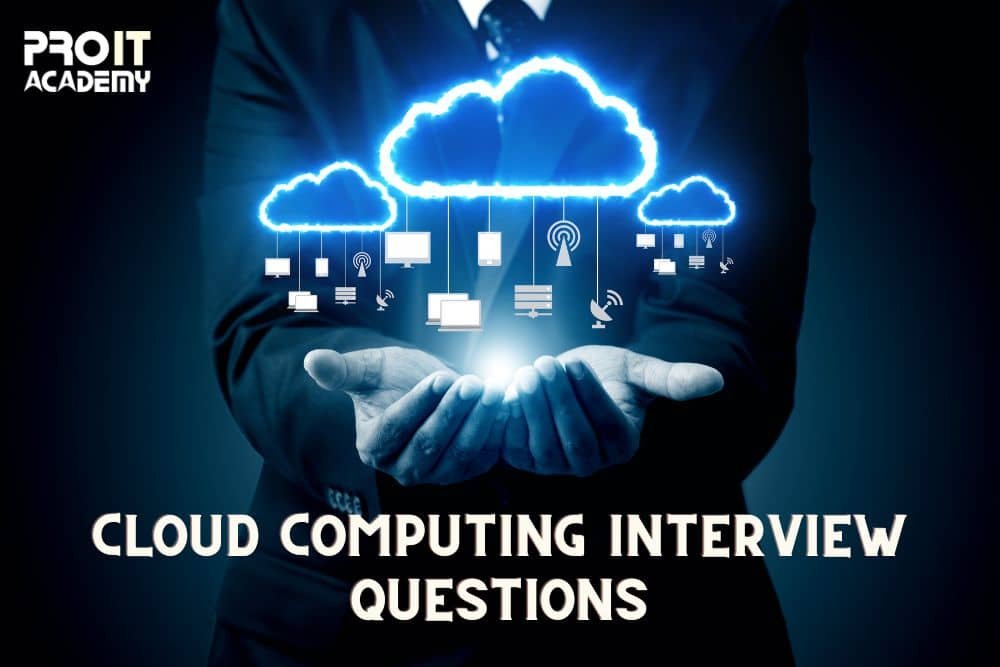The popularity of jobs associated with cloud computing is getting hike with time. When you do a quick search on LinkedIn, you will find a number of jobs in Cloud Computing. As many companies are switching to the cloud, job growth is automatically increasing. Hence, they need engineers who will help in transitioning over Cloud Computing or senior engineers.
What is actually cloud computing?
Cloud computing is defined to be a group of networks, services, hardware, and storage that are known to deliver computing over the internet. It might seem to be complex, but Cloud Computing is no rocket science. Cloud computing is undoubtedly an on-demand demand in the IT field. In simple terms, it is a delivery of computing services like storage, servers, networking, databases, software, and intelligence over the internet.
Looking for an upsurge in cloud computing jobs, the candidates have to prepare themselves likewise. So, we are here trying to mention some of the best cloud computing interview questions and answers to increase the chance of accomplishing your dreams. By getting the knowledge of these questions, you can easily improve your skills.
Top 50 cloud computing interview questions and answers
Here is a list of some important questions and their answers associated with cloud computing.
- What are the different kinds of models associated with cloud services?
Some of the different types of cloud services models –
SAAS – SAAS provides users with software that is used as a service that resided on a cloud. The software and applications are used on a subscription basis. The providers will look into the maintenance and upgrade of the software.
IAAS – IAAS is known for renting hardware/infrastructure to different companies.
PAAS – PAAS deliver organizations with a platform where they can easily deploy the code and applications. It offers a platform used for developing and testing with storage, data, and computing capability.
- How will you define the component layers available in Cloud architecture?
There are generally 5 layers of cloud architecture mentioned –
- Cloud Controller (CLC) – CLC is present at the topmost layer and responsible for controlling virtual resources such as networks, servers, and storage.
- Cluster controller – It is used for controlling the execution of all kinds of virtual machines that are generally stored on the nodes.
- Walrus – Walrus is used as a storage controller and is meant for dealing with various virtual machine images as well as user data.
- Storage controller – As the name suggests, a storage controller is used for handling storage in a block which is usually attached to virtual machines.
- Node controller – The node controller is designed for controlling the functions of the hypervisor. This means it is used for controlling different VM activities. For the information, a hypervisor is present as a hardware-supported emulation technology.
- Define some of the famous use cases for cloud computing
Here are some of the use cases related to cloud computing.
Cloud storage – Currently, storage over the internet is definitely a boon because it makes use of a web interface. The introduction of cloud storage allows users to only pay for the storage they are using.
Test and development – Cloud is known for offering read-to-use, tailored, and set-up resources. It provides the infrastructure meant for the development and testing of different services and applications.
Data backup – It is an effortless kind of work and is available with security as well as the availability of resources. It’s not like older strategies which have loopholes and have the probability of getting corrupted.
Big data analytics – Cloud technologies and big data go parallel and are useful in making systems faster, safe, high-performance, scalable and affordable.
Disaster recovery – When someone is using cloud computing techniques, then data recovery becomes much more affordable. This shows cloud can easily store data on various servers at different locations.
- How will you define On-demand functionality?
Clouds generally comprise numerous systems and resources that can easily be modified on the basis of customers’ demands. This helps in offering easy scalability and saves money.

Book Your Time-slot for Counselling !
- What are various kinds of deployment modes available on the Cloud?
Usually, there are four kinds of modes which are defined as –
Public – It is available for all and can be used easily.
Private – This is a kind of resource collection used by private companies for their own requirements.
Hybrid cloud – Hybrid cloud is available as a mix of public and private clouds which can easily switch from one source to another completely depending on requirements and conditions.
Community cloud – Many organizations can access the services and systems at the same time to share information.
- Who are cloud consumers available in a cloud ecosystem?
There are individuals and groups present in businesses that make use of numerous kinds of cloud services to accomplish tasks. A cloud consumer can easily use the computing services offered by a public cloud.
- How can you explain direct customers available in the cloud ecosystem?
Someone who wants to take the benefits of services created by a business can use a cloud environment. Basically, the end users don’t have any idea about which cloud they are using.
- Tell us about the cloud storage levels
Cloud storage device mechanism includes different levels of data storage mentioned as –
Blocks – A block is defined as the smallest unit of data that can be accessed individually. It is considered to be the lowest level of storage.
Files – Files are defined to be collections of data that are further grouped into files located in folders.
Objects – When data and metadata are associated together as web-based resources are known as objects.
Datasets – Data sets are usually organized in a table, record, or delimited format.

- Define the platforms used for cloud computing
There are different cloud computing platforms named as –
Hadoop – It is used for clustering of hardware and analyzes large sets of data simultaneously.
Map-reduce – This platform allows the users to resize the Hadoop clusters present within Amazon infrastructure.
Apache Spark – Apache spark is described to be an open-source analytics engine that is used for processing large datasets. It generally offers parallel processing and fault tolerance using cluster management. In short, it forms a complete solution for big data.
- Describe the difference existed between elasticity and scalability
Elasticity is defined as the decommissioning and commissioning of a large number of resources which usually depends on the place where traffic is either high or low. Yes, elasticity is very handy when used in a shared cloud. On the other hand, Scalability allows the resources to get increase or decrease depending on the customer’s workload.
- How cloud computing differs from mobile computing?
Mobile computing is linked with mobile tablets and devices as it is accountable for accessing the internet. As compared to cloud computing, mobile computing is more user-friendly whereas cloud computing is used by enterprises to use their services.
- Why do people use cloud computing?
Cloud computing is used as a computing resource offered by dedicated servers as well as cloud providers over the internet. These services can easily be stored and organizations ensure quality control.
- Describe something about cloud-native
It is used as technology or you can services to leverage the cloud architectures.
- What is meant by edge computing?
Edge computing is performed at a centralized place having resources. One can get the direct advantage in form of low latency and minimal dependency on outdoor resources.
Pro IT Academy offers AWS with Python Training in Pune for freshers and experienced.
- Describe something about the multi-cloud strategy.
The multi-cloud strategy is used for increasing independence and minimizes the risk of failure or preventing traffic overload.
- Tell about the serverless components present in cloud computing
Serverless components find in cloud computing basically allow the creation of applications to take place without thinking about any complexity of managing the infrastructure.
- Define basic kinds of data centers
Low-density data center – Low density is named because the servers can easily be placed at some distance in low-density data centers.
High-density data centers – As compared to low-density, these are faster but at the same time cause heating issues.
- How you can ensure security in clouds?
Here are some factors that can ensure security.
- Access control
- Identity management
- Authentication
- Authorization
- What are microservices?
Microservices is described as a process including the development of applications having codes that are independent of each other.
- How will you differentiate between cloud and traditional data centers?
If we talk about traditional data centers, they are more costly than cloud ones because of the traditional databases. This causes overheating issues along with hardware and software problems.
- What do you understand by EUCALYPTUS – Elastic Utility Computing Architecture?
EUCALYPTUS is an open-source software infrastructure present in cloud computing. It is used for creating public, private, and hybrid clouds. Moreover, it is also useful in linking the programs to systems and creating data centers.
- What is meant by cloud VPN?
Cloud VPN is helpful for many companies transitioning their VPN services t the cloud. VPN acts as a tunnel between the cloud and companies while such a connection doesn’t need any kind of public IP address.
- What are the fundamentals required for moving to a cloud platform?
Here is a list of some important fundamentals needed to transfer to a cloud platform.
- Data storage kinds
- Compliance problems
- Business continuity
- Reduction of downtime
- Maintaining data integrity
- Confirm access and availability
- Fail-safe for loss of data
- How will you define CaaS?
CaaS is defined as a terminology that is used widely in the telecom industry as Communication As A Service. It offers features like desktop call control, desktop faxing, and unified messaging.
- Differentiate between RPO and RTO in cloud computing services
Recovery Point Objective is presented as a maximum amount of data loss. The data loss is usually measured in time. On the other hand, Recovery Time Objective is the maximum time accepted by a company to wait for recovery.
- How a resource agent can monitor the usage of a cloud?
The resource agent is the one who collects the usage data with event-driven interactions and resource software. He makes use of metrics depending on pre-defined and different observational events.
- What do you mean by Cloud-native applications?
‘Cloud-native’ is known to be a software framework that is designed to have microservices, containers, and dynamic orchestration.
- Give the details about the architecture for VPC (Virtual Private Cloud)
VPC is responsible for storing and computing different resources for different organizations. This can be done by offering a layer of abstraction and isolation. VPC comprises different components like –
- Network ACL
- Route table
- Security Groups
- How will you define virtualization in Cloud Computing?
Virtualization offers an abstraction that exists between user programs and the back end. It generally creates an environment where different software makes use of the same hardware. Apart from this, virtualization is also known for managing service-level policies.
- What do you mean by Edge Computing?
Edge and cloud are known to complement each other. Unlike cloud computing, edge computing is related to physical locations and issues associated with latency.

Do you need help to create your career path ?
- Tell us something about API Gateway
An API Gateway makes multiple APIs work together and acts as a single gateway while offering a uniform experience to the user. API gateway manages the APIs centrally and offers enterprise-grade security.
- Mention some of the use of APIs in cloud computing
API works as instrumental in cloud platforms because.
- It is meant for eliminating the requirement of writing complete programs.
- It offers instructions to make communication between one or more applications.
- It helps in creating different applications and links with the help of cloud services and other systems.
- How will you define Rate Limiting?
Rate Limiting is defined as a method to limit the network traffic and can be run within an app in spite of the server. It can easily remove suspicious and harmful activities.
- What is meant by encapsulation in cloud computing?
A container in cloud computing is defined to be a packaged software code that comes along with all kinds of dependencies. It is so because the container runs in the cloud and on-premises smoothly. Such kind of packaging up of code is known as a process of encapsulation. It becomes important for the developers because they don’t have to further develop the codes depending on the individual environment.
- What do you mean by Containerized Data Centers?
Containerized Data Centers are defined to be traditional data centers that permit a high level of customization with the help of servers, resources, and mainframes.
- What do you know about system integrators?
System integrators are useful for bringing the system components as a whole and making sure that the system works properly.
- Explain to us about a Private Cloud
A private cloud is meant to deliver the benefits which are usually similar to a public cloud, including self-service and scalability. Therefore, it is considered to be best for businesses that practice dynamic or unpredictable computing.
- What is Public Cloud?
The public cloud is known as a third-party application that can be used by anyone to get access to them. That means, public clouds are open to people and focus on certain layers such as cloud applications, providing platform markets, and offering infrastructure.
- How will you define the usage of utility computing?
Utility computing is present as a provisional model. The customers are charged depending on the usage of computer resources and infrastructure management. Utility computing is used as a plug-in that is generally managed by an organization.
- What did you mean by low-density data centers?
Low-density Data Centers are optimized in a way to provide high performance. The space constraint is being removed and there is also seen an increased density in these data centers.
- What is the scope of cloud computing in the future?
While focusing on the advantages of cloud computing to organizations, it is true that the popularity of cloud computing is increasing. It helps people to deal with issues like big data, cyber security, and internal control.
- Tell us about the security risks involve in cloud computing
There are certain factors that are responsible for cloud computing delivering the advantages. But, still, there are some securities issues like –
- Loss of data
Data loss is a major risk when it comes to cloud computing. In such a situation, the data can be leaked, corrupted, deleted, or misused by the user.
- Insecure APIs and hacked interfaces
APIs and interfaces are the common things that connect people to the internet. It’s a golden chance for hackers to attack them because both APIs and interfaces are available in the public domain.
- Data breaching
A data breach occurs when secured data gets illegally retrieved and the chance of hacking can increase.
- Tell us about the resource replication in cloud computing
Resource replication is defined to be a process of creating multiple instances associated with similar IT resources. Generally, to implement a resource replication mechanism, virtualization technology is used.
- What is big data in cloud computing?
Cloud computing suppliers make use of the ‘Software as a Service model that allows the users to simply method information. The information is generally controlled via a cloud computing platform.
- Define the importance of the virtualization platform
A virtualization platform is meant for allowing someone to decouple the hardware from the software. Basically, it manages the service level policies along with the cloud operating system.
- What are the different phases involved in cloud architecture?
There are some important layers involved in cloud architecture named –
- Launch phase
- Monitor phase
- Shutdown phase
- Cleanup phase
- Mention various types of EC2 instances
- Memory-optimized instances – This type offers fast performance for applications. It usually includes support for improved networking.
- Compute-optimized instances – Such kind is known to offer high-performance computing resources as well as fast-batch processing.
- Accelerated optimized instances – These make use of co-processors and hardware accelerators in order to improve performance.
- What do you mean by Cloudformation’s function?
Cloudformation is defined as a process of creating and maintaining AWS infrastructure and stacks.
- What is the role of the performance cloud in cloud computing?
Performance cloud in cloud computing is helpful in transferring a large amount of data quickly.
- What is the optimizing strategy in cloud computing?
The concept of three data centers is related to overcoming maintenance costs and optimizing resources. Moreover, it also gives quick recovery and backup.
All these mentioned questions and answers are useful for applicants who are seeking their future in the IT sector.
At ProIT Academy, you can apply for Cloud computing Course and prepare yourself to get a job in multinational company to secure your future.












